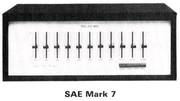"off duty" 1970 - 1997 - eine Freizeit-Zeitung für's US-Militär
Die in diesem amerikanischen (Freizeit-) Shopping-Magazin angepriesenen Hifi- und Video-Produkte waren auschließlich amerikanischen und kanadischen Militärangehörigen zugänglich - also zu kaufen - und vor allem zu ganz ungewöhnlich (verblüffend) niedrigen US $ Military-Preisen. Zu der einführenden "off duty" Seite geht es hier lang. - Um 1970 begann der weltweite Hifi-Boom bis zum 1. Crash 1978 und dann wieder zum 2.Crash um 1990. Über die 20 Jahre nach 2001 lesen Sie mehr in den Kolumnen auf diesen japanischen Seiten.
.
Hifi-"Spezialgeräte" aus dem Dezember 1972 und Januar 1973
Hier werden die damals noch "besonderen" oder "anderen" Hifi-Einzelgeräte - die "separates" - aufgelistet und beschrieben und auf dieser Seite mit Military-Preisen verbunden.
Zu dieser speziellen Hifi-Einzelgeräte - Liste des Vorjahres 1972 geht es hier lang.
"annual survey" - (zu bezahlende) jährliche Marktübersicht
.
The Custom-Designed System
With special components you can build any kind of audio setup you want
By THOM PRINGLE - Off Duty / Europe / January 1973
.
SO YOU WANT TO SOUP up your system, eh?
You say the "normal" 40-watts-per-channel, ultra-sensitive, all-in-one units aren't enough to turn you on? Or you want to convert your present stereo system to 4-channel? Then, you are looking for one of the special or super components in the next few pages.
Not many people start right out with the super gear and we don't recommend that they do. If you are, in fact, starting a system for the first time, (and thousands of people do start while overseas) you may not really know what kind of a system you want and probably would find that you really don't want a super system at all, but just a good, high-quality system.
On the other hand, there are thousands of you old hands out there who have been around audio equipment for years and are just begging to jump into the plus-ultra stuff. Listed on these pages are some of the finest units made -with gold-plated price tags, though, even with military discounts.
Do a little something special
Of course, there are many of you who would like to do a little something special without ruining your bank balance. You may want to sneak into the 4-channel game, Dolbyize your recorder or add a special speaker control circuit to your system.
You'll find low-priced units that let you do these things listed here along with the big expensive jobs. For instance, if you happen to have four speakers already, you can go 4-channel for less than $20. And, to scare the noise out of your recorder, you can add a Dolby unit for about $50. So there really is something here for everyone and, for most of our audiophile friends, this SHOPPER is the most interesting and enjoyable of all.
Amplifiers.
These units have the basic job of increasing signal strength and they do it in two ways - by increasing voltage and by increasing current. Naturally, there are specific design and operating considerations for each job and, therefore, there are two types of amplifiers - preamplifiers and power amplifiers. You can, of course, buy an integrated amplifier which has both of these amplifiers in one unit but you may want special features in each section which you can't find in all-in-one units.
.
Preamplifiers.
You'll find both stereo and 4-channel preamplifiers listed and, in most cases, they will have frequency responses which are so good (3 Hz to 100,000 Hz, for instance) that you rarely have to be concerned about it. Therefore, in checking out a preamplifier, look at its special features and hum-and-noise (S/N ratio) rating.
Many preamplifiers have built-in equalizers, 4-channel matrix decoders and special control circuits. If you desire certain functions in your preamplifier, chances are you can find them if you search long enough since just about any combination of special features can be found.
A preamplifier should produce as little noise as possible and may be rated for hum and noise by some manufacturers or signal-to-noise ratio (S/N ratio) by
others. In any case, expect a figure of 70 to 80 (for example, hum and noise - 75dB or S/N ratio 75dB) from high-quality preamplifiers. The higher the figure, the better the performance of the unit.
.
Power amplifiers.
The separate power amplifiers today are true super amps with fantastic capabilities and astounding specifications. Power outputs extend up to hundreds of watts (RMS) per channel with 0-100k Hz frequency response and practically unmeasureable distortion. Most all of the power amplifiers have unusually good specs and, therefore, if you're thinking of buying one, about all you really have to be concerned about is how much output you want and your financial condition.
How much power you need depends on several factors, the largest of which is the type of speaker system you want to drive. If you have very inefficient speakers, such as acoustic suspension types, you may need tremendous amounts of power to produce low-frequency transients. But, here again, it depends on how demanding you are and whether you are willing to spend a lot of money to obtain the best low-frequency reproduction.
.
Equalizers.
When you get to the place where you start worrying about the total performance of your system, you are ready for an equalizer.
The equalizer can be adjusted to compensate for the aggregate response of your amplifier, speakers, room acoustics and even your ears' response. As you can see, it is possible for an equalizer to make a big contribution toward the overall sound of your system, depending on how irregular the response of your system is.
Of course, it's also possible that an equalizer will do very little for your system, so if you can talk a friend into loaning you his, you can see how much an equalizer can do for you before buying.
Basically, an equalizer allows you to adjust the response of your stereo system to give you the kind of effect you want. The equalizers usually have one control for each frequency range - most offering at least five frequency range controls.
For families which take their listening seriously, each member of the family can keep a chart of the control settings which suit him best and the equalizer can be reset depending on who is listening to the system. Equalizers cannot be classed as inexpensive additions to your system, but can offer definite advantages to the serious audiophile.
.
4-channel adapters.
There are three 4-channel disc encoding systems still slugging away to see who will come out on top in the 4-channel game; CD-4 (30 kcyles subcarrier), SQ (matrix) and "regular" (matrix). So, for the individual who wants to go 4-channel, it is necessary to cover all three possibilities thereby eliminating future obsolescence of equipment. Fortunately, most of the 4-channel equipment available handles at least SQ and regular matrix material and has plug-in provisions for easy conversion to CD-4 operation. Some units also have circuitry for making stereo material sound like 4-channel by using reverberation or derived signals.
.
Many types of adapters
In this SHOPPER, you'll find many types of adapters and units which can be added to your system. There are preamplifiers, integrated amplifiers, straight decoders, synthesizers and all sorts of combinations of these devices. If you are thinking about going 4-channel, we strongly suggest that you carefully inspect any unit you are considering to make sure it will do what you want it to. One specific problem to keep in mind is that the high-level matrix decoders, designed to be added to the output of a stereo amplifier, are not capable of handling discrete 4-channel sources such as 4-channel tape recorders.
.
Reverberation units.
The reverberation units listed in this section are strictly reverb units (combined with necessary amplifier circuits) and are meant solely for producing reverb effects. There are, however, in some of the 4-channel units, reverb units which are used to produce 4-channel effects with stereo material.
Most of the genuine reverberation units use the Hammond-type delay unit, with a few using acoustical tubes in which microphones and miniature speakers are used. Controls are usually limited to a type of feedback control which determines how long the reverberation continues.
.
Noise reduction units.
Dynamic noise reduction units are here to stay and the most popular system is the Dolby system. Other systems exist, of course, but it looks like the Dolby B-type process has things pretty well wrapped up.
In effect, the Dolby circuit is a dynamic high frequency filter which varies the high frequency of your tape recorder in such a way as to reduce the apparent noise level. The idea has received wide endorsement and is now being applied to FM broadcasting as well.
The Dolby units listed are meant to be used as tape recorder control units which are connected to the inputs and outputs of your recorder and stereo system. Any material passing between your system and the recorder must pass through the Dolby unit where it is processed. All of the units have the necessary controls and meters for calibration, and once calibrated usually do not need to be bothered again.
The main question to consider when buying one of these noise reduction units is whether you want simultaneous record/playback capability. If you have a three-head tape recorder and want to monitor off the tape, then you'll have to spring for one of the larger units which means a bigger price tag.
Miscellaneous:
There are many other types of special components being produced which make interesting additions to a stereo system. Among those available to military buyers are switching units, electronic dividers, and test units.
If you are an individual who has built-up a collection of different types of equipment over the years and likes to make comparisons, you probably have some method which allows you to connect the various pieces of gear into your system.
The whole process can be simplified with one of the comparator units now available. They vary in complexity from simple switch circuits to relay operated, remote controlled professional units. Again, these are items for the real audio enthusiast, but they sure beat stringing things together with alligator clips.
.
bi-amp or tri-amp systems
When a loudspeaker system splits up the incoming signal to divide it among the various speaker elements (woofers, tweeters, etc), the cost in power is actually greater than most people realize. For this reason, the electronic crossover networks were designed to be used before the power amplifiers thereby increasing the efficiency of the overall system.
This, then, requires additional amplifiers, and is called the bi-amp or tri-amp system depending upon the number of divisions produced. Several manufacturers produce these electronic crossover units which are crossovers only and
not power amplifiers (with the exception of the Altec 771-BX).
.
audio test units
One of the most entertaining pieces of gear is also the least necessary - the audio test unit. Actually, an attractively packaged oscilloscope, the units often have built-in oscillators, meters, switching circuits and calibration standards. The most complete models allow you to make some very exacting tests of professional quality and almost all have connections for FM multi-path displays.
You'll probably want to complete the rest of your stereo system before investing in one of these units, but they are a lot of fun and will just impress the daylights out of your next-door neighbor.
Super components and specialty devices are becoming increasingly popular and you'll see a lot of them in the future. While you'll never be able to keep up with all of the developments, the many models you do have available to you can add a lot to the performance and enjoyment of your system.

































